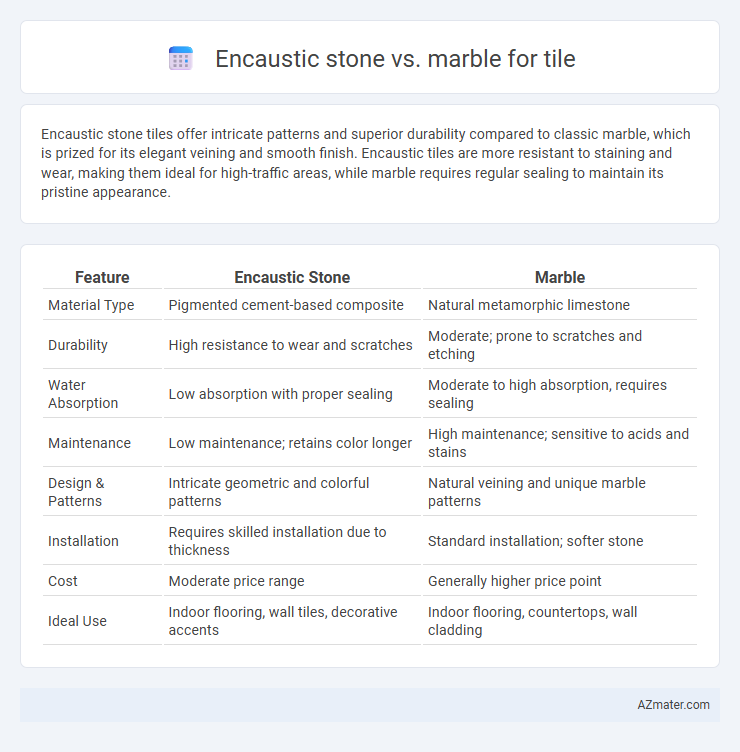Encaustic stone tiles offer intricate patterns and superior durability compared to classic marble, which is prized for its elegant veining and smooth finish. Encaustic tiles are more resistant to staining and wear, making them ideal for high-traffic areas, while marble requires regular sealing to maintain its pristine appearance.
Table of Comparison
| Feature | Encaustic Stone | Marble |
|---|---|---|
| Material Type | Pigmented cement-based composite | Natural metamorphic limestone |
| Durability | High resistance to wear and scratches | Moderate; prone to scratches and etching |
| Water Absorption | Low absorption with proper sealing | Moderate to high absorption, requires sealing |
| Maintenance | Low maintenance; retains color longer | High maintenance; sensitive to acids and stains |
| Design & Patterns | Intricate geometric and colorful patterns | Natural veining and unique marble patterns |
| Installation | Requires skilled installation due to thickness | Standard installation; softer stone |
| Cost | Moderate price range | Generally higher price point |
| Ideal Use | Indoor flooring, wall tiles, decorative accents | Indoor flooring, countertops, wall cladding |
Introduction to Encaustic Stone and Marble Tiles
Encaustic stone tiles are crafted using a unique technique that involves inlaying different colors of clay to create intricate patterns, offering a durable and decorative flooring option with a matte finish. Marble tiles, formed from metamorphic limestone, are renowned for their elegant veining and polished surface, providing a luxurious and timeless aesthetic in interior design. Both materials differ significantly in maintenance, durability, and visual appeal, making selection dependent on specific design requirements and functional needs.
What Is Encaustic Stone Tile?
Encaustic stone tile features a unique surface created by inlaid colored clays rather than a surface glaze, offering vibrant patterns and durability ideal for decorative flooring and wall applications. Unlike marble, which is a natural metamorphic rock with a smooth, polished finish and subtle veining, encaustic tiles provide more design versatility and color retention, being resistant to wear and moisture. Encaustic tiles are typically made from a blend of cement and pigments, making them a cost-effective and environmentally friendly alternative to traditional natural stone like marble.
What Is Marble Tile?
Marble tile is a natural stone tile created from metamorphosed limestone, prized for its unique veining and durability in flooring and wall applications. It features a crystalline structure that provides a smooth, polished finish, making it a popular choice for elegant and timeless interior designs. Compared to encaustic stone tiles, marble offers greater strength and a more sophisticated aesthetic but requires regular sealing to prevent staining.
Aesthetic Differences: Encaustic Stone vs Marble
Encaustic stone tiles showcase intricate patterns and vibrant colors created by layering pigmented clays, offering a more decorative and artistic aesthetic compared to the natural veining and smooth, polished surface of marble tiles. Marble presents a timeless elegance with unique organic swirls and a glossy finish that enhances light reflection, while encaustic tiles provide a matte, textured appearance that adds visual interest and vintage charm. The choice between encaustic stone and marble for tile design depends on whether the desired look is bold and patterned or classic and refined.
Durability and Longevity Comparison
Encaustic stone tiles offer exceptional durability due to their dense composition and resistance to scratches, stains, and wear, making them ideal for high-traffic areas. Marble tiles, while visually striking with natural veining, are softer and more porous, prone to scratching, etching, and staining without proper sealing and maintenance. In terms of longevity, encaustic stone maintains its structural integrity and color retention over decades, whereas marble requires regular sealing and careful upkeep to preserve its appearance and prevent damage.
Maintenance and Cleaning Requirements
Encaustic stone tiles require sealing to prevent staining and regular gentle cleaning with pH-neutral cleaners to maintain their intricate patterns and surface integrity. Marble tiles demand more intensive maintenance, including frequent sealing and the use of specialized marble cleaners due to their porous nature and susceptibility to etching from acidic substances. Both materials benefit from immediate spill cleanup, but marble's higher sensitivity makes it more prone to damage without careful upkeep.
Installation Process: Encaustic Stone vs Marble
Encaustic stone tiles require precise cutting and sealing during installation to maintain their intricate patterns and prevent color fading, making the process more labor-intensive compared to marble. Marble tiles demand careful handling due to their softer composition and susceptibility to chipping, often requiring specialized adhesives and grout to ensure durability. Both materials benefit from professional installation techniques, but encaustic stone's intricate design patterns necessitate extra attention to alignment and sealing to preserve aesthetic quality.
Cost Analysis and Budget Considerations
Encaustic stone tiles generally have a higher upfront cost compared to marble due to their handcrafted production and unique patterns, making them a premium choice for budget-conscious projects. Marble tiles vary widely in price depending on quality and origin, often presenting more affordable options but with increased maintenance expenses over time. Budget considerations should include long-term durability and maintenance costs, with encaustic stone offering greater resilience and lower upkeep compared to the porous nature and susceptibility to staining of marble.
Best Applications for Each Tile Type
Encaustic stone tiles excel in decorative applications such as accent walls, backsplashes, and feature flooring due to their intricate patterns and vibrant colors. Marble tiles are best suited for high-end residential floors, countertops, and bathrooms where elegance and durability are paramount. Both materials perform well in interior settings, but marble offers superior resistance to wear in heavy-traffic areas compared to encaustic stone.
Environmental Impact and Sustainability
Encaustic stone tiles are often made from natural, eco-friendly materials like clay and pigments, resulting in lower carbon footprints compared to marble, which requires intensive quarrying and high energy consumption. Marble extraction and processing generate significant waste and habitat disruption, while encaustic tiles can be produced with less environmental harm and often incorporate recycled components. Choosing encaustic stone tiles supports sustainable construction practices by minimizing resource depletion and reducing overall environmental impact.

Infographic: Encaustic stone vs Marble for Tile
 azmater.com
azmater.com